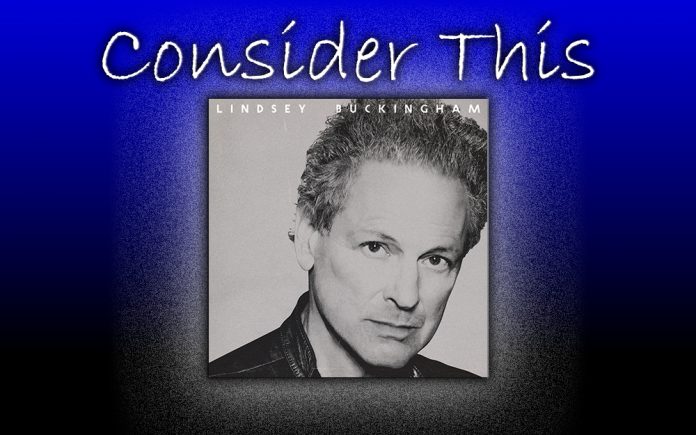
By Eleni P. Austin
For better or worse, when Lindsey Buckingham and Stevie Nicks joined Fleetwood Mac in 1975, they turned a moderately successful British Blues Rock band into legit superstars. Purists may grumble and grouse, arguing the virtues of songs like “The Green Manalishi” and “Oh Well” (and, yeah, those are killer songs). But if band continued down that path, they would probably be regarded now as a footnote on par with also-rans like Blues Incorporated, Savoy Brown and Steam Hammer
So, it came as quite a shock in 2018 when Fleetwood Mac ousted Lindsey Buckingham just weeks before a World tour was to commence. The band recruited ex-Tom Petty Heartbreaker guitarist, Mike Campbell and Crowded House leader Neil Finn to cover guitar and vocals. Apparently, it took two guys to fill Lindsey’s very talented shoes.
Born in late 1949, Lindsey Adams Buckingham was born in Palo Alto, California and grew up in near-by Atherton, the youngest of three brothers. As a kid he began picking out tunes on his Mickey Mouse toy guitar. Pretty soon he was playing along with his brother Jeff’s extensive 45 collection. Recognizing his talent, his parents bought him a $35. Harmony guitar.
Despite never taking guitar lessons or learning how to read music, Lindsey was a quick study. By age 13 he became interested in Folk music, adopting an energetic guitar style that mimicked the banjo he heard on Kingston Trio records. A few years later he was playing bass and singing in his high school band, the Psychedelically inclined Fritz (originally known as The Fritz Rabyne Memorial Band). Before he finished school, he invited his friend Stevie Nicks to join the band as an additional vocalist. By the time Fritz had called it quits in 1971, he and Stevie became romantically involved.
Securing a record deal, and now known as Buckingham Nicks, the couple released a self-titled debut in 1973 that (despite its slightly provocative cover that featured both of them topless and included some side-boob from Stevie), promptly sank like a stone. Having moved to Los Angeles to make the record, the pair were barely making ends me. Concurrently, after myriad line-up changes, Fleetwood Mac had recently ditched gloomy London for the smoggy sunshine of L.A. In the process of looking for a studio and producer to make their next album, Mick Fleetwood was at the Sound City facility when producer Keith Olson cued up the Buckingham Nicks album to demonstrate the studio’s capabilities. The band’s co-founder/drummer was intrigued. Bob Welch was the most recent Mac guitarist to leave the fold and Mick, along with bassist John McVie and his wife, vocalist and keyboard player Christine were searching for a new guitarist. They invited him to join, but Lindsey would only accept if his girlfriend Stevie was included. They were a package deal.
In 1975, the newly minted quintet released their second self-titled album. Lindsey, Christine and Stevie had each contributed original songs and the record began a slow and steady ascent up the charts. Three singles hit the Top 20 and the finally the album reached #1 only to be eclipsed by Peter Frampton’s live juggernaut, Frampton Comes Alive.
Two years later their sound truly coalesced with Rumours. By this time the McVie’s had filed for divorce, Mick’s marriage was in trouble and Lindsey and Stevie were in the midst of an acrimonious split. But the emotional mishegoss only fueled their creativity. Much like his hero, Beach Boys mastermind, Brian Wilson, Lindsey emerged as the band’s sonic architect, equal parts adventurous and meticulous.
Something a sun-kissed Soap Opera, Rumours fused scathing sentiments like “Loving you isn’t the right thing to do… packing up, shacking up is all you want to do” to ridiculously hook-filled melodies. The album spawned four hit singles and perched at the top of the charts until it was knocked off by the Saturday Night Fever soundtrack. All told, the album has sold 40 million copies and is the second biggest selling album in history.
In the ensuing years the Mac continued to make amazing records like 1979’s expansive and experimental Tusk, and 1982’s crowd-pleaser, Mirage. Their multi-platinum success allowed each member to indulge themselves chemically and creatively. In 1981 Lindsey, Mick and Stevie all released solo albums. Lindsey’s Law and Order was a quirky masterpiece, but only Stevie’s Belladonna came close to matching Rumours massive sales. Christine quietly released a solo album in 1984. (John’s lone solo album arrived in the early ‘90s).
By 1987, Fleetwood Mac felt more like a business and less like a band. The Tango In The Night album arrived and predictably zoomed up the charts. But (like most mid ‘80s music), their sound had become slick and polished. The endearing rough edges that defined their ‘70s material had been scrubbed clean. Although he had committed to a tour, Lindsey quit before the band hit the road. Feeling creatively stifled, he complained that he was expected to create commercial hits, rather than follow his own esoteric impulses. The band soldiered on without him, but Stevie jumped ship by 1991.
In 1993, Fleetwood Mac reconvened to play Bill Clinton’s Presidential Inauguration (the “Rumours” era hit, “Don’t Stop” had become a Clinton campaign anthem). But it was another four years before they truly reunited. They recorded The Dance in front of an invitation-only audience. The live, unpluggyish effort reaffirmed the band’s superstar status and they quickly returned to the road. But Christine’s fear of flying prompted her to retire following the band’s induction into the Rock & Roll Hall Of Fame.
As a four-piece Fleetwood Mac released Say You Will in 2003 to mixed reviews and respectable sales. Touring sporadically, Linsey and Stevie continued to release well-received solo albums. Once she conquered her Aerophobia, Christine was welcomed back into the fold in 2014. Both Lindsey and Christine had written a clutch of new songs, but Stevie was reluctant to return to what she characterized a combative environment in the studio. The chemistry between Lindsey and Christie was fresh and undeniable. So, the pair pooled their resources and released an eponymous duo album in 2017 and briefly toured behind it.
At the start of 2018, just as the five-piece was gearing up for a world tour, following a performance at the annual MusicCares benefit, management phoned Lindsey and he was summarily fired from the band. Accounts vary as to cause, the story that gets the most traction is that Stevie issued a “him or me” ultimatum. Lindsey filed suit that October for breach of fiduciary duty and breach of oral contract among other damages. It was settled in December.
Three months later he underwent emergency heart surgery. The procedure caused some temporary vocal damage, but he had already recorded his seventh solo album. Of course, Covid 19 derailed his original 2020 plans to release the album and tour and he hunkered down with his wife and kids. Perhaps there was too much togetherness, earlier this June his Kristen Buckingham filed for divorce. In recent interviews Lindsey says he is hoping they reconcile.
In between Fleetwood Mac duties, Lindsey has managed to carve out a rewarding solo career. From his 1981 debut, through 1984’s ambitious Go Insane, 1992’s more conventional Out Of The Cradle, 2006’s dazzling Under The Skin, 2008’s intricate Gift Of Screws, 2011’s slightly ramshackle Seeds We Sow, plus an assortment of live efforts. Now he has finally released his seventh long-player, succinctly self-titled Lindsey Buckingham. The record kicks into gear with the primal musical therapy of “Scream.” Strummy acoustic guitar is augmented by dissonant bells that randomly ping and ting, glassy electric guitars, gamboling bass and a heartbreak beat. Lindsey’s constricted tenor is enhanced by his own triple-tiered harmonies on the chorus. Vaguely priapic lyrics chart a carnal course from zero to sixty; “Over and over, red, red rover, til the sun starts setting in the West/Nighttime’s the the I love so much, lost in the language of your touch, just like you’re waking from a dream, oh I love it when you scream.”
Both “Swan Song” and “Blind Love” detail the workaday woes and enervating ennui that characterizes a long-term romantic relationship Although the songs were written a few of years ago, in light of the Buckinghams’ recent split and possible reconciliation, they take on an added resonance. On the former, tightly coiled guitar notes are quickly supplanted by angular bass and jittery drum loops. Rippling Spanish guitar darts through the mix, as lyrics navigate the hairpin turns of love that’s coasting on fumes; “It’s another fight as the queen dims the light, it’s far too late at any rate, it’s up to fate/It always ends up black and white, but is it right to keep me waiting, is it right to make me hold out so long, is it right to keep me waiting in the shadow of our swan song?” Lindsey rips not one, but two pithy guitar solos, the first is buzzy and bee-stung, the second careens through the dense arrangement with a Khachaturian kick.
The latter finds Lindsey at his most Beach Boy beatific. Chiming guitars, time-keeper bass and whooshy keys are tethered to a clip-clop gait. Lindsey’s unadorned vocals ride roughshod on the verse, stacked harmonies breathily float on the chorus. From the opening couplet, lyrics listlessly catalogue the telltale signs of marital monotony; “You feel love but you never give it to me, you steal love when you’re looking right through me…” By the chorus, it’s cards on the table time; “Blind love, show me your soul, if you’ve been lying to me, I’ve got to know…if you’ve been playing a part, I’ve got to understand.”
Actually, the album’s unofficial leitmotif seems to revolve around rocky relationships, connubial and otherwise. The best tracks on the album circle around a recurring theme of potential loss. Take the winsome “Blue Light.” The melody is powered by trademark banjo-riffic Buckingham guitar riffs, see-saw bass and a galumphing thump. Yin-Yang lyrics like “Still crying about joy, still laughing about pain…still dreaming about hope, still hoping about dreams, cause nothing is quite what it seems,” acknowledge that sometimes resilience and perseverance can transcend tsuris. So, no matter what “we can never, never, never, never, never give in.” Kaleidoscopic guitar notes shadow the chorus giving the arrangement a buoyant fizz that belies the song’s somber subject.
“On The Wrong Side” weds plinky keys, winsome guitars and wiry bass lines to a pogo-ing, percussive beat. Channeling the bitter kiss-off of “Go Your Own Way,” the lyrics obliquely address his years as the creative linchpin of Fleetwood Mac; “Every now and then I fall, every now and then I rise, when my back’s against the wall, still sometimes I compromise.” A crush of layered vocals on the chorus adds a delirious ebullience that almost feels incongruous. Especially when juxtaposed with the stinging guitar solo he unleashes on the break. Toward the end of the track, he acridly quips “We were young and now we’re old, who can tell me which is worse,” before closing out the song with a final skronky, squally guitar solo that sputters into the ether.
“Power Down,” much like “Swan Song” is anchored by skittering drum loops along with braided guitars and angular bass. Wiry and kinetic, it’s an aural Pop Art collage (with the emphasis on Art), that recalls the experimental “Tusk” era, (which displayed Lindsey’s growing affinity for bands like Devo and Talking Heads, much to his bandmates’ chagrin). Lyrics mine the fertile territory of domestic discord; “Far, far in between these wounds I mend, you said your beginning was my end,” and his mien splits the difference between defiant and self-pitying, But by the bridge he has soothed his bruised ego, urging us to “remember or we might forget.”
Finally, the painterly “I Don’t Mind” is equally avant-garde. Hushed vocals and fleet, filigreed acoustic fretwork partners with Dada-esque bass and percolating percussion. Cascading electric licks ping-pong through the mix. Hiccup-y harmonies jigsaw beneath Lindsey’s whispery tenor. Lithe and elastic electric notes zig-zag through the arrangement, the lyrics offering this philosophical nugget to ponder; “Yesterday, today, tomorrow end before they start, where there’s joy there must be sorrow, never far apart.”
Other interesting tracks include the shimmery homeowner Blues of “Santa Rosa” and a courtly take on “Time.” The song was originally a hit in 1966 for the Pozo-Seco Singers. A favorite going back to his high school days, Lindsey barely tinkers with the source material, front-loading the song with celestial harmonies and breezy guitars. The album winds down with the slightly somber “Dancing.” Thisclose vocals breathily annunciate lyrics that equate the intersection of art and commerce with creative carnage. It also feels like a sideways swipe at the monolithic Mac; “Emptiness goes where supply meets demand, business and murder go hand in hand, dancing, dancing.” It’s a curious end to a pretty great record.
Lindsey played everything on here, electric and acoustic guitars, guitar synthesizer, bass, synthesized bass, keyboards, percussion, drum programming and the latticed vocals. The whole thing was recorded in his home studio, and the results are seamless.
In the Fleetwood Mac universe, Stevie Nicks is the certified superstar, but Lindsey is forever the quixotic and cranky boy wonder. On his solo stuff he can tilt at windmills, he can follow his muse, dirty up the pretty and, to paraphrase Brian and the Beach Boys, stay true to his school. That compulsion has earned him a loyal and passionate fan base. Diplomacy and genius don’t always go hand-in-hand. He may never regain his spot within the Mac hierarchy. But if he stays on his solo path and continues to make captivating and complex music like this, he should be okay.










































